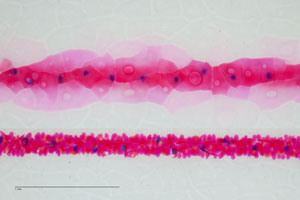High Humidity Can Cause Color Bleed in Some Digital Prints
On September 22nd, 2010 IPI staff member, Dr. Gene Salesin presented the results of his work on colorant bleed in digital prints at NIP 26, in Austin, Texas. Inspired by anecdotal evidence from the field, this original project replicated the effect of high humidity on digital prints (photographs and documents) and ranked the various digital print colorants according to the propensity to bleed. A major finding of this study was that humidity-induced colorant bleed is limited to dye inkjet prints, including both photos and documents. The bleed can be severe leading to color shifts and loss of image detail in photographs and compromised readability of text in documents. While increasing levels of humidity led to increase the levels of bleed, it is not known if periods as short as a day or even hours at extremely high humidity can be noticeably harmful.

More research is thus needed to determine the absolute limits of temperature, humidity, and time combinations that a dye inkjet print can tolerate before undergoing colorant bleed. As institutions move their materials into and out of controlled environments for the purpose of transport, patrons use, or display, it is critical for them to know what limits must not be crossed in order to prevent irreversible harm.
A PDF of the full study can be downloaded here.

IPI Receives Grant from IMLS to Study the Effects of Airborne Pollutants on Inkjet Prints
IPI has recently received funding from the Institute of Museum and Library Services (IMLS) for a major research and development project dealing with the mitigation of pollution-induced deterioration of digitally printed materials in cultural heritage institutions.
According to our 2008 survey, approximately 80% of cultural heritage institutions already have inkjet prints in their collections. The survey also showed that noticeable deterioration of these objects has already occurred, including fading, yellowing, color bleed, and surface cracking and delamination. In total, 71% of institutions have identified deterioration of materials in their digital print collections. IPI's previous digital print research, (the DP3 Project, funded by the Andrew M. Mellon Foundation and IMLS), established a clear connection between ozone and nitrogen dioxide and the forms of deterioration noted above. Identifying and understanding effective methods to mitigate such damage can be critical to the survival of these objects.
Deterioration due to pollutants occurs through chemical reactions. It may be possible to slow these reactions by lowering the storage temperature or by using enclosures to prevent contact between the pollutants and the collection objects. The specific experiments in this project will quantify the overall effectiveness of low temperature in slowing the attack by atmospheric ozone and nitrogen dioxide, as well as characterize the degree of protection afforded by various common enclosures (sleeves, boxes, etc.) made of paper or plastic. The outcome of this project will be a full report describing the results, including improved recommendations to institutions regarding the best practices for managing the preservation of modern digitally printed materials.

ID Tip: Offset Lithography or Digital Press?
Like offset lithography, digital press (DP) is used in production scale printing. A digital press uses electrophotographic technology, with either dry toner or liquid toner as its colorant. Unlike offset lithography, it does not require a physical master, which makes it a versatile, high-speed, print-on-demand production printer. In spite of these two technologies being so different, prints produced by them may be mistaken for one another at first glance: both technologies may use coated or uncoated, matte or glossy papers, and both frequently produce rosette dot patterns –amplitude modulated (AM) screens. In the case of offset lithography and dry toner DP, patterns of irregular appearance –frequency modulated (FM) screening- are also an option. So how can we tell them apart?
Read More |